Fansly Vs OnlyFans: Which is the Best Platform for Creators?
Thinking about content creation? You probably already know about OnlyFans; it's a name that pops up all the time. Fansly, on the other hand, is another big player in the space that has been getting a lot of attention lately.
This is when things start to get hard. As a new user, it can be hard to choose between Fansly and OnlyFans.
Which platform is better? Which one will help you get more followers, connect with real fans, and, most importantly, make money? The truth is that each platform has its own pros, cons, and quirks.
This detailed guide will explain everything you need to know about Fansly and OnlyFans. It will look at the main differences, the pros and cons of each, and help you choose the one that works best for you. You'll have a much better idea of where to start by the end.
What is OnlyFans?
Let's begin with the most popular platform. OnlyFans was founded in 2016 and has experienced significant growth since then. It's likely been discussed extensively on social media because it's become the most well-known name for content that you pay for.
OnlyFans is a platform where creators can earn money from their work, primarily by charging users monthly fees. Your audience pays a monthly fee to see your exclusive content. You can also make money through tips, pay-per-view (PPV) messages, and live streams. It's easy to set up.
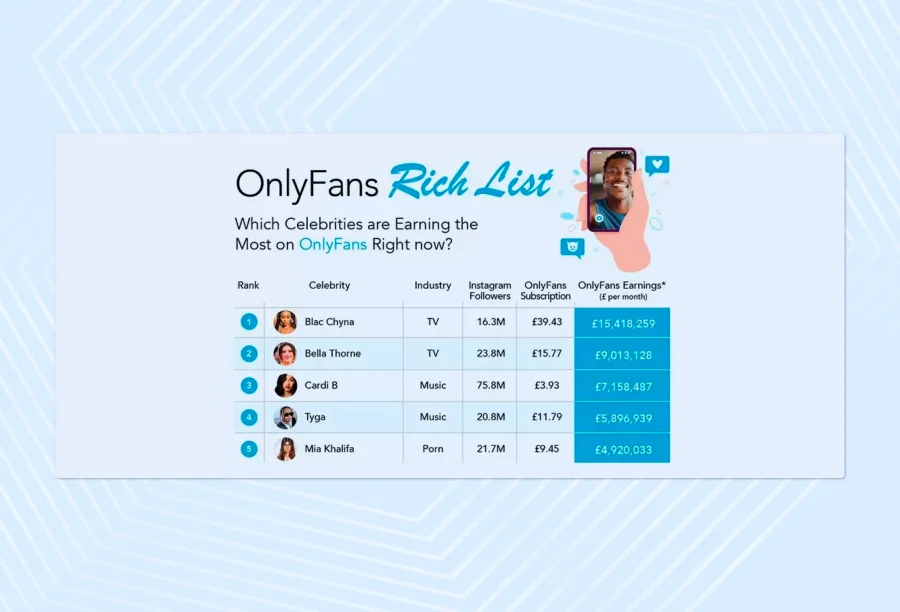
OnlyFans became so popular because it lets creators set their own prices and control their own content. OnlyFans differs from regular social media in that creators typically don't receive direct payment for their work.
Instead, OnlyFans lets you turn your content into a steady source of income.
What is Fansly?
Fansly is the newest player on the scene. Fansly is a newer site than OnlyFans. It started in 2021. That doesn't mean it's not a serious contender, though.
Fansly was made to be a direct competitor to OnlyFans, but it has some unique features. The people who made it looked at the OnlyFans model and tried to improve it, and in many ways, they have.
Fansly's tiered subscription model is one of the things that make it stand out. Fansly allows you to set up multiple subscription levels at different prices, whereas OnlyFans typically offers only one price per creator.
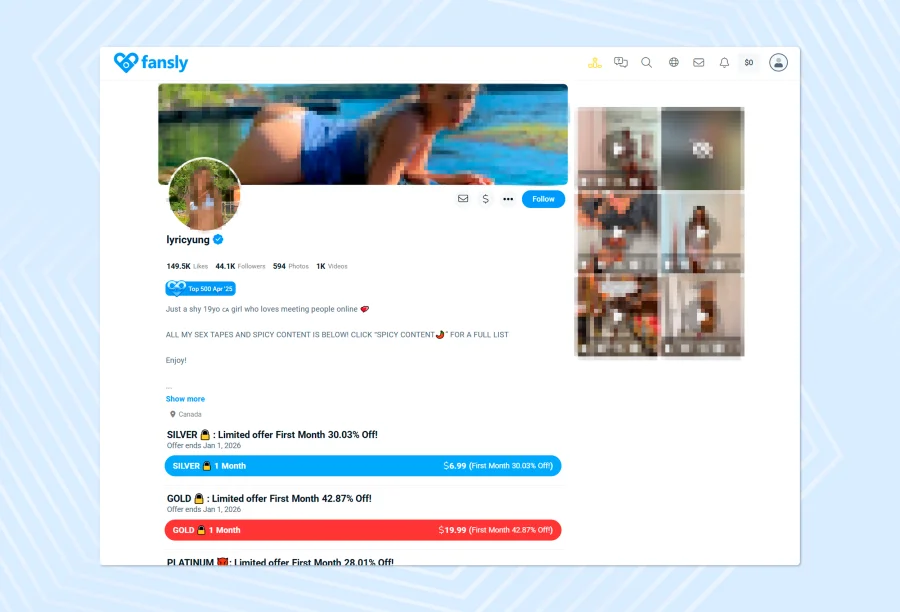
Think of it as giving different levels of access: a basic level for casual fans, a premium level for your most loyal fans, and other levels in between.
Fansly also puts a lot of effort into helping creators get more fans. It features more advanced analytics, a more flexible content structure, and several unique features that will be discussed later. It was built from the ground up with input from creators in mind.
Key Similarities Between Fansly and OnlyFans
Before we delve into the differences, there are several notable similarities. There are so many similarities between OnlyFans and Fansly.
Monthly Subscription-Based
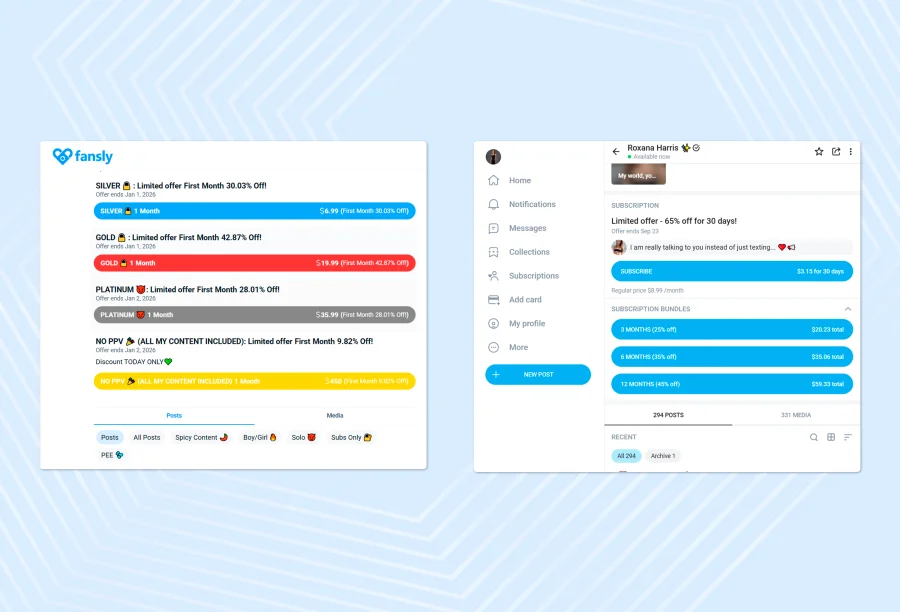
Creators both on OnlyFans and offer a subscription (monthly) model where fans pay to access your exclusive content each month, which is great because you have transitioned from generating money from isolated sales to building a source of predictable, recurring income.
Core Content Features
Creators on both OnlyFans and Fansly can share pictures, videos, message their subscribers directly and share live streaming content. Live streaming is a great feature in both apps, as it enables you to build a more personal connection with your followers.
PPV Messages
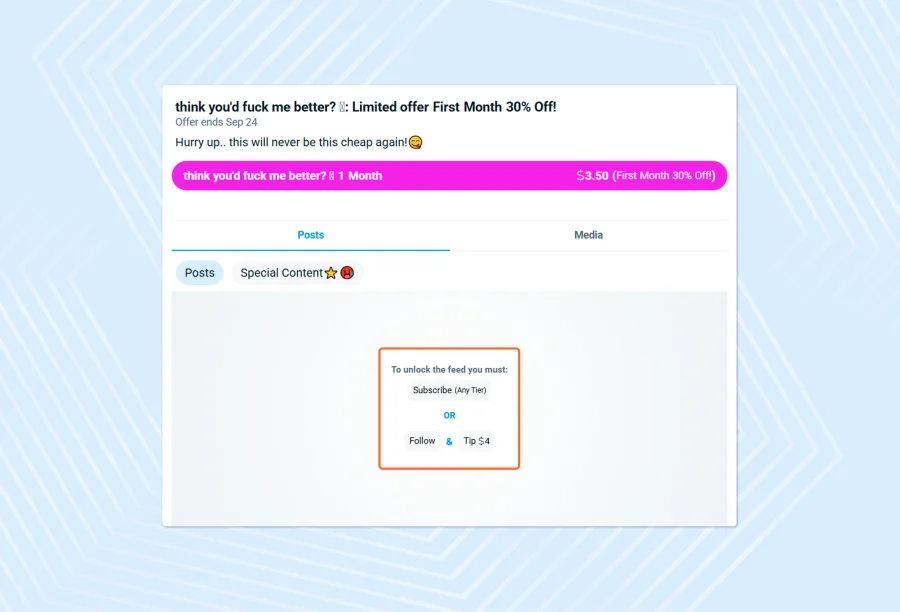
Both platforms also allow you to send PPV messages. This allows you to sell exclusive, unlocked content to your subscribers, generating additional revenue beyond your monthly membership subscriptions.
Support
Fanlsy and OnlyFans both have safer measures and support for content creators. There are community standards in place to assist in the protection of their content creators; Both platforms have creator verification, as well as content restrictions to better protect their community.
Key Differences Between Fansly and OnlyFans
Now, onto the fun. While both apps look similar in the beginning, once you really use them, you will discover some major differences that may weigh your decision seriously.
1. Features and Tools
Starting here, the most creator-friendly features, Fansly aims to differentiate itself from OnlyFans. Fansly offers additional features and tools, providing more feature-rich content and analysis than OnlyFans.
For instance, some of the features/tools include information on subscriber behaviours, analysis of your content, and analysis of your revenue trends, which can encourage your decision-making in your business.
The structure of content on Fansly is also more flexible. You can have different collections and group your content by theme, which can be a useful feature for subscribers who don’t know what they want. OnlyFans has a more streamlined interface, and some creators may prefer that, but others may feel that way is a bit limiting.
One very interesting feature of Fansly is how it handles subscription tiers. While OnlyFans typically offers a single subscription tier, Fansly enables you to have multiple tiers with varying prices and different levels of access to content. This is similar to the way you might have bronze, silver, and gold membership levels.
2. Payment Methods and Payout Options
Now let’s get to the practical details: how do you get paid? Both platforms offer several methods for receiving payouts, but there are some key differences.
OnlyFans, as the older and more established platform, is more familiar to payout processors. This may provide more regular payouts, but creators have often reported experiencing delays in receiving their payouts.
Fansly has taken a different approach, generally offering you more ways to receive payouts. They have successfully adapted their platform to different regions and currencies, which is a positive for creators, especially those not based in the US or UK.
Similar payout schedules are available on both platforms, typically offering weekly or bi-weekly payout options, depending on your chosen payout method and options.
3. Platform Fees and Earnings
Now let’s talk money, because this is why any creator does what they do. OnlyFans takes a 20% commission on your earnings. So when you earn £100, you take home £80. This model and commission percentage have existed for many years.
Fansly also takes a 20% commission. For creators who already have their own business on OnlyFans, this won't be anything unusual, but for those just starting their careers, the commission might be unexpected.
However, earnings potential is not just about commission percentages. Several variables must be considered, including audience size, platform features, and the most effective way to monetize your content.
4. Popularity and Audience Size
In terms of audience size, this is likely OnlyFans' greatest advantage. When people think of subscription content, they think of OnlyFans. The name has essentially become the business model.
OnlyFans has millions of users and millions of creators, which means a large potential pool of subscribers. The disadvantage is more competition. It can be challenging to stand out from the crowd.
Fansly has a smaller user base, but it is growing rapidly. The advantage is less competition, largely due to a smaller user base. The downside? A smaller pool of subscribers to sell to.
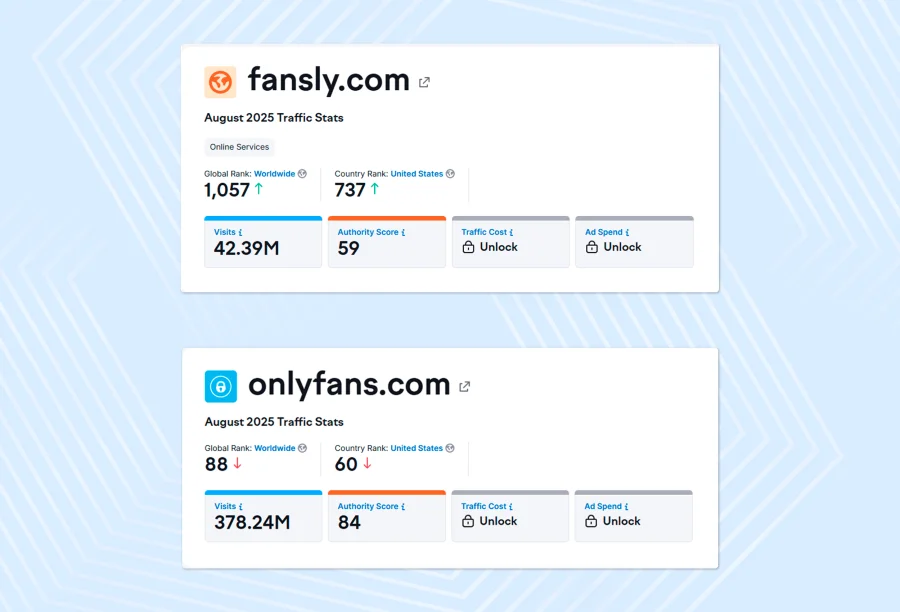
Think of it like this: opening a shop in a busy city centre compared to opening a shop in a small town. One has the advantage of foot traffic, while the other has less competition.
5. Content Guidelines and Restrictions
Both OnlyFans and Fansly allow adult content; however, each has a different approach to content policy.
OnlyFans has a long history of instability with its content policy. One of the more infamous times was in 2021 when OnlyFans attempted to ban adult content. This event left many creators uncertain about making OnlyFans their sole income stream.
On the other hand, Fansly, as a platform, has been more stable in regard to content policy. Fansly is seen as more creator-friendly. Overall, Fansly has avoided those unstable policy shifts that could potentially wipe out your income overnight.
Each platform has a verification process and performs age verification for its creators. Each platform does not allow illegal content or content that violates the Terms of Service.
Pros and Cons of OnlyFans
To make it easier to get a clearer picture of the pros and cons of OnlyFans, we've summarized some things to think about below.
Pros:
- Big Market. OnlyFans is the leader in the industry, meaning it will be the first place an overwhelming number of consumers will look for subscription content. It's similar to being on Google, as opposed to an off-market search engine. You have so many more opportunities to be seen.
- Brand Recognition. OnlyFans has a popular name. You mention OnlyFans, and people automatically know what you mean, which will make marketing much easier.
- Platform Reliability and Familiarity. Being a more established platform has also helped eliminate many bugs, and it is typically very user-friendly, albeit a bit rudimentary, for new creators learning how to set up a platform.
Cons:
- Higher Commission Rates. Although not significantly higher than other platforms, a 20% commission is still higher than some of our competitors.
- Fewer Creator Tools. In comparison, analytics and creator tools are relatively basic and rudimentary in relation to newer platforms.
- A History of Policy Instability. Building your entire business on a platform with a history of substantial and abrupt policy changes is somewhat unsettling.
Pros and Cons of Fansly
So, what about Fansly? Here is a summary of its pros and cons.
Pros:
- Less competition. Although Fansly is a relatively new platform, the ratio of creators to the number of fans on the platform is completely different from the situation on OnlyFans. Less competition will be an advantage for creators who are just starting their careers.
- More Features and Options. Fansly offers a wide range of features and options across its tiered subscription plans. More features also mean it can help you specialize for fans at different budgets and price points. It also offers better analytics and more scheduling/plan modification options.
- More Responsive. Although it is still early in their growth, the vibe I get from Fansly is that they are more responsive to creator input. As a smaller corporation, they also seem to adapt more quickly to changes that members request and would like to see.
Cons:
- Smaller Audience and Less Brand Recognition. Fansly has a significantly smaller audience compared to OnlyFans, resulting in a smaller potential subscriber base for your content. You may have to expend more energy in terms of external marketing to attract subscribers, or risk having to explain what the fan's lacquer is.
- Potential Technical Roadblocks. Fansly, being a newer platform, may be more prone to glitches and technical issues, or simply have features that have not been thoroughly tested as they could be on a more established site. Its support mechanisms are also a little more personable, but potentially lack the robust features of a more established site.
Which platform pays more?
That is the dollar question. The issue is that it depends on other factors beyond the commission rates.
OnlyFans is much more popular, so there is a higher potential of getting followers and earning more with its subscription model, even with the increased commission.
The tiered membership on Fansly may even earn you more than usual for each subscriber. Rather than one subscriber spending $10 a month, you can now attract someone to spend $25 a month on the premium subscription. The flexibility may significantly increase your average revenue per user.
Many successful creators already use both platforms and find that their total income from both platforms is more than it was when they were on OnlyFans. It is as if you diversify your revenues.
The earning potential is actually limited only by your capacity to market yourself, create engaging content, and build a relationship with your audience. The platform is merely the technology- it is how you use it that will determine your success.
Which platform is better for beginners?
This is a crucial decision for beginners. Both platforms are of use to new creators in their own ways.
OnlyFans may be simpler to get started with because it is more well-known. When creating your initial subscribers, it can be an advantage to use a platform where people have already been exposed to.
OnlyFans’ user interface is also fairly simple. There are no complicated features to learn, allowing one to concentrate on creating content rather than trying to determine how to utilize the platform.
However, here, Fansly could be an even better option - it is less competitive. With millions of creators on OnlyFans, it can be very difficult to stand out when becoming an emerging creator. One will be discovered on Fansly more easily.
More robust analytics on Fansly can also help newer creators determine what is driving traffic and what is not. You no longer have to guess: you have exact statistics on your content performance.
That reduced commission rate means you take home more of your money from the very first day. Earning increment increases are important as soon as you are generating your income.
My advice? Fansly is a good option if you feel more equipped to manage your content yourself and don't mind being more in control of the approach. Utilizing OnlyFans will enable you to find the most direct route with the potential to reach the largest audience.
Between, if you’re new to OnlyFans, we’ve written a detailed guide on how to make money on OnlyFans for beginners.
Can creators use both Fansly and OnlyFans?
Absolutely! In reality, most designers employ a combination of the two platforms, and it is becoming quite natural. You can and in fact should have more than one account on more than one platform, as it is a clever business strategy.
Subscribing to both Fanly and OnlyFans allows you to mix up your ways to earn money. When technical troubles or a change of policy happen in one of the platforms, you are not totally screwed. You know you have backup.
Some creators have different strategies on each platform. Perhaps they have more premium content on Fansly that would be included in the tiered subscriptions, while still using OnlyFans to attract a broader audience.
They can also experiment with new content types on the smaller Fansly base, to introduce them to their larger OnlyFans audience.
The trick is ensuring that you are not merely copying/pasting across platforms. Make each platform unique so that your subscribers will see something new or, at the very least, differently organized. Otherwise, what is the reason to subscribe to both?
However, be sure to remember that it is time- and labor-intensive, as you need to administer more than one platform. You will be required to create content on both, communicate with subscribers on both and manage the administrative side of both accounts.
FAQs about Fansly vs OnlyFans
Is Fansly safer than OnlyFans?
Both platforms are serious about safety, as they verify the identity and content of users. Fansly may edge slightly in policy stability, as they have not implemented a stunt like OnlyFans did in 2021 regarding the detection of adult content. At any rate, both are relatively safe to operate- as long as a creator adheres to the regulations, that is.
Do Fansly and OnlyFans have similar audiences?
There must surely be an overlap, and the audiences have some differences. OnlyFans has a mainstream audience largely due to its size and name recognition.
The customers of Fansly are generally more tech-savvy and open to using newer resources. Both groups want to get access to exclusive content and have direct contact with the creator.
Which platform is easier to get started on?
OnlyFans has an easier interface that is understandable to absolute beginners. However, with better analytics and tools to get yourself organized, Fansly can even be easier to expand once you learn to work with it.
It mostly depends on your knowledge of technology or comfort level with it, ranging from simpler to advanced.
Can you transfer subscribers from OnlyFans to Fansly?
You can not directly move subscribers, but you can definitely market your Fansly account to your current OnlyFans subscribers. Many creators reference other platforms on their profiles or in their content. However, be sure to align with the terms of service of both platforms as you crossover.
Conclusion
Where does this bring us in the Fansly vs. OnlyFans debate? The truth is that both platforms have their advantages, and the easier decision to make is the decision that better serves your individual intentions and needs.
OnlyFans remains at the top of the hill when it comes to the largest potential audience and higher fees. It has a name, a huge number of users and an established track record. It is challenging to stand out among creators who prioritize reach over other factors.
However, if you prefer access to better creator tools, lower fees, and more freedom in how you form your subscriptions, Fansly is something to consider. The platform will also provide an opportunity for creators to optimize their content strategy, thereby increasing their earnings per subscriber.
So, this is my opinion: why choose just one channel to monetize your content, and not all of them? Many artists who have achieved success with these sites combine the use of Fansly and OnlyFans to maximize their earnings and safeguard themselves against policy shifts or technical issues.


